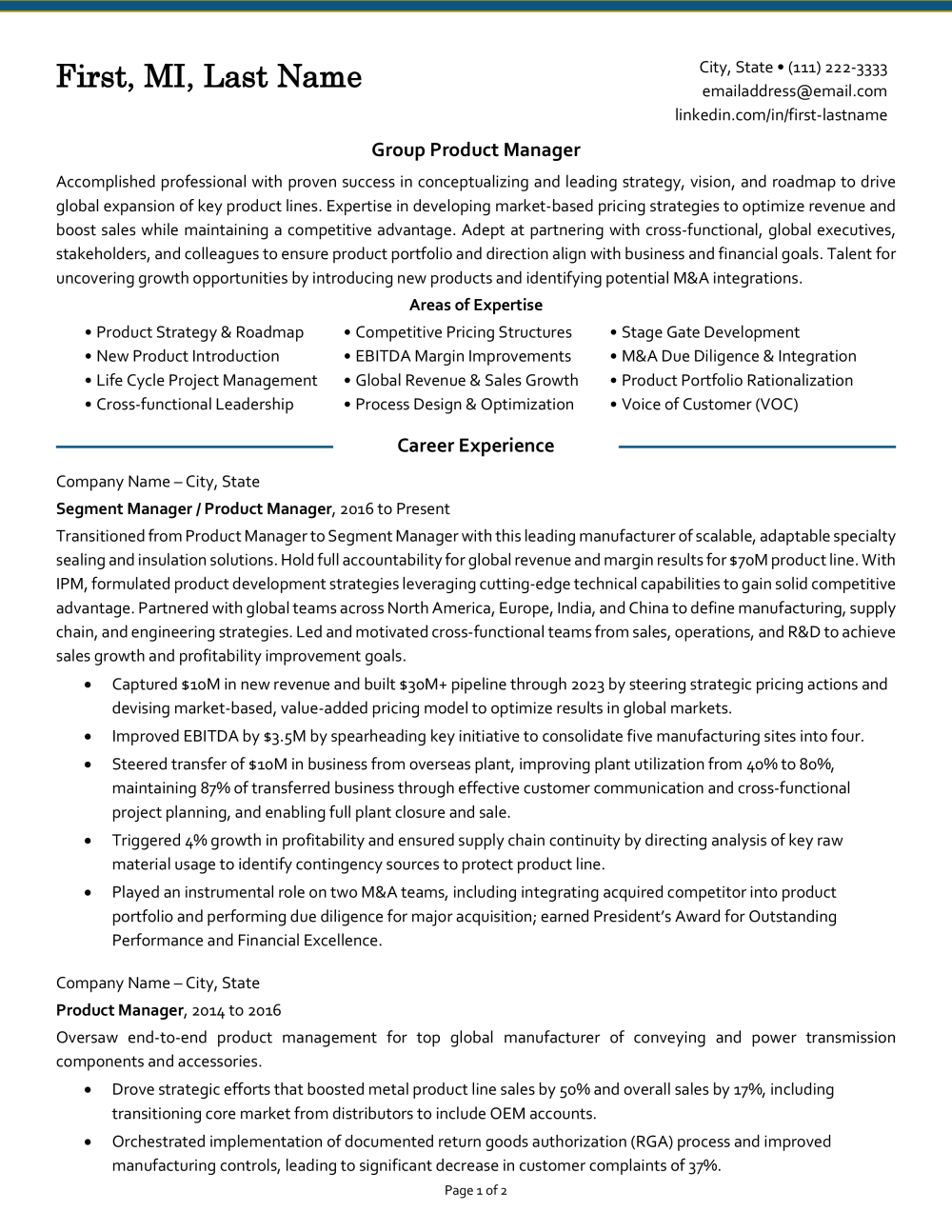US Resume Format: How to Write and Best Practice Examples

13 min read

Are you a foreign national applying for your first job in the US? If so, did you know that the standard US resume format often differs from requirements in other countries? Therefore, you'll want to use the appropriate US resume format to increase your chances of landing a job.
Or maybe you’re a US citizen, searching for your first or next work opportunity. In that case, ensuring your resume is up to par with current US resume formatting requirements is worth the effort.
Regardless of which scenario represents you, we’ve got you covered. In this article, we'll go over the information you need to include on a resume in the US, information you should never include, and best practices to present your information in the best possible light. Tips on how to write your resume, with a sample resume template, are also included to help increase your chances of getting a job in the United States.
What are the different US resume format options?
There are three primary types of US resume formats:
The traditional reverse chronological format
The strategic functional layout
The best-of-both worlds hybrid resume
All of these options include similar information, but with a different layout. This piece will focus on the reverse chronological resume format, which is the most common and familiar format used in the US.
What to include on a US resume
Here’s the basic information a hiring manager or employer in the US is looking for on your resume:
Name and contact information
Skills
Work experience
Qualifications
Generally, the work experience section will make up the majority of your resume when using a reverse chronological format, unless you have little to no work experience. In that case, your education section will take center stage.
You can optimize your resume with keywords tailored to the job position you’re applying for. For more information on what your resume needs to include, check out these resources:
What not to include on a US resume
There are several types of information you should exclude from your resume if you want to be a competitive applicant in the US. Don't include any of the following, unless specifically directed otherwise by the employer:
Personal details. These include your date of birth, gender, religion, country of origin, ethnicity, marital status, or identification numbers, such as your social security number. US employers don’t need or want to see this information during the application stage, since it can lead to discrimination and confidentiality concerns.
A headshot. Including a photo raises another discrimination issue by identifying your sex, and potentially your age and ethnicity. It also takes up valuable room on your resume that’s better used to describe your suitability. Only provide a headshot or photo if asked to do so, or if you're in a profession that requires it, like entertainment or the performing arts.
Your full address. Stick to the city or location of where you live, plus the state. Street names or numbers provide too much information and take up space unnecessarily.
Country prefix. You should include a phone number on your resume, though only if it’s a 10-digit US number. Include your area code but not the country prefix. Example: (555) 555-5555.
References. Only include references if the job posting specifically instructs you to provide them. Most employers will ask for references later in the hiring process if they want them.
Exam scores. Including your ACT, SAT, GMAT, TOEFL, or other test scores on your resume is not standard practice. Hiring managers are more interested in your experience and education.
Resume best practices for US applications
Now that you know the basics of what to include and what not to include for US employers, it's time to dive into some US resume formatting best practices.
Layout flow
The standard US resume begins with your name and contact information at the top. From there, you'll include your headline, professional profile, core competencies / skills, work experience, education, and certifications, typically in that order. Depending on your circumstances, you may add specialized content, like volunteer experience, awards, publications, and organizational affiliations.
Formatting standards
Margins, line spacing, font size, font type, and resume length are all considerations to ensure you meet US resume formatting guidelines.
Margins should be set at minimum of a half-inch at the top and bottom and three quarters of an inch on the sides, with the maximum being one inch all around.
Use between 1.15 and 1.5-point line spacing between text and double lines after headings.
The font you choose should be easy to read. Georgia, Arial, Lato, Helvetica, Cambria, and Calibri are all good resume font options.
Make the text easy to read. Use a font size of 10 to 12 point for the content that falls under each section of your resume. Titles and headers should be around 14 to 16 point font.
Use a resume template that already has the formatting set up.
Regarding length, your resume should be one to two pages in length, maximum. If you're early in your career, stick to one page. If you're an experienced professional, two pages is acceptable. Only in rare instances should your resume ever be longer than two pages. You might be able to get away with three pages if you're applying for a high-level senior or executive role, have been asked to list all your past work experience in detail, or are applying for jobs where longer resumes are expected, like academic positions or US federal government jobs.
Template selection
The template you choose should be modern and ATS-friendly. Simple is best when it comes to the style of your resume. Black and white is standard and it's best to use bullet points with plenty of white space. Resumes with dense sections of content can frustrate the reader, reducing your chances of landing an interview. Avoid using graphics on your resume unless you're in an industry that warrants it, like fashion or graphic design. Even then, be mindful of an employer's applicant tracking system (ATS) scans.
Employers use applicant tracking systems to streamline the hiring process. One capability of an ATS is rank job applicant resumes. If you want to get your resume to rank highly:
Avoid using designs, images, tables, charts, and fancy designs - clean, simple, and concise is best
Avoid acronyms and spell out abbreviations, so that you maximize the number of keywords in your resume
Send your resume file as a Word or PDF document with standard 8.5 X 11 sizing
Use an ATS-friendly resume template, like one of the 200 examples of downable ATS-compatible templates available on ZipJob
Only include information that’s relevant to the job you're applying for
Optimize your resume with keywords relevant to your target role
Keyword inclusion
Keywords not only help your resume to rank highly if it’s scanned by an ATS, but also grab the reader's attention to show you're a viable candidate for the job. Identify keywords to incorporate by reviewing the job posting and looking for the skills and phrases that align with your competencies and past achievements.
Expert Tip
Don’t keyword stuff. Keywords should be included so they’re part of the natural flow of your resume.
Content development
US hiring managers are looking for the potential value you can add to the organization. Regardless of your titles or positions, you must show what you bring to the table. You want the reader to be able to easily and quickly view your abilities and accomplishments that represent your potential to succeed.
When developing content for your resume:
Focus on experience and achievements that directly relate to the position you're seeking.
Use numbers to quantify achievements. Quantifiable data is a way to show, rather than tell the hiring manager what you're capable of. It allows them to visualize your potential in the role. For example, "Developed new process to collect customer satisfaction data, increasing customer response rates by 15%” is more informative and intriguing than "Developed process to collect customer satisfaction data."
Use American English with zero spelling or grammatical errors.
Be honest and accurate. Getting caught in a lie can mean losing out on the opportunity or even having an offer rescinded.
Omit details that don't support or add to the narrative.
How to write a resume for US employers
Now it's time to create the perfect US resume to land an interview. Below are five steps with examples to help you along the way. There’s also a full resume template to refer to at the end, so you can see the correct US resume format and flow discussed in each section.
1. Provide your contact information
The first thing recruiters and hiring managers should see on your resume is your contact information, which includes:
First and last name
City and state
Phone number
Email address
LinkedIn URL
For example:
John Smith
Phoenix, AZ | 555.555.5555 | name@email.com | linkedin.com/in/name/
You can opt to leave off the LinkedIn URL. Alternatively, you can include a URL to your online portfolio or professional website. If you provide a URL, only choose one (LinkedIn is most common) and be sure the page is current and represents you well.
2. Include a compelling headline and professional profile
The next section of your resume will include your headline and professional profile, sometimes referred to as a summary statement or professional summary. The headline highlights your job title or focus. The professional profile is a brief introduction that emphasizes your key accomplishments and skills and how you can add value to the organization. The goal of your profile is to grab the recruiter or hiring manager's attention and entice them to continue reading your resume.
Here's an example:
Senior Marketing Director
Dedicated and ambitious marketing and communications leader with a keen understanding of market dynamics that impact regional, national, and international advertisers. Proven record of success in penetrating new market segments and steering account development, with more than 20% revenue growth over two quarters and a 30% increase in accounts in one year. In-depth knowledge of integration best practices across content types and mediums. Expert in creating successful brand strategies for organizations ranging from start-ups to Fortune 500s.
3. Highlight your skills and core competencies
Adding a core competencies section to your resume is another way to emphasize that you have the knowledge base to get the job done right. A list of core competencies can grab the attention of hiring managers and also help your resume to rank highly with an ATS.
As a staple of any good resume, there are two types of skills you can highlight in this section:
Hard skills are the technical skills you possess and can be specific to particular jobs. Microsoft 365, typing, and AutoCAD are examples of hard skills.
Soft skills are the personal skills you have. They’re necessary to succeed at most jobs and can be transferred between roles and sectors Interpersonal skills, effective communication, and creativity are examples of soft skills.
Some choose to include a core competencies or skills section at the bottom of their resume. However, it’s best to include your list of skills below your profile summary and above your work section so it’s one of the first things the reader sees. Additionally:
Tailor your core competencies list for each job posting. Be sure to include the ones you possess that are outlined in the job description.
Keep your list short and focused, with about 8 to 10 skills included.
As an example, an Accounting Specialist might include the following core competencies on their resume:
Certified Public Accountant | QuickBooks | Accounts Receivable | Research | Team Leadership | Accounts Payable | Collections | Customer Service | Tax Accounting | Risk Assessment
4. Showcase your work experience
Unless you have little to no work experience, the work experience section of your resume is most important. In this section, you tell your story and highlight your achievements. The typical US resume format includes the following work details:
Job title. The job title is listed first, allowing the reader to quickly see the positions you've held and how they're relevant to the job.
Company name and location. List the company name and location below the job title. It's also an option to include a brief one-line summary of what the company does below the company name, if it isn't a well-known organization.
Dates you held the position. Include the years you held the position to the right of the job title.
Remit. Include a brief overview of the remit of the role.
Accomplishments. The core part of each job entry you include is the list of accomplishments and achievements. List about five to seven accomplishments for each position held.
Here are some pointers for completing the work section of your resume:
Tailor your resume to align with the job description. Review the job description carefully and ensure that any skills and accomplishments you have that meet the job requirements are included on your resume.
Use powerful action verbs at the beginning of each achievement listed and use different verbs throughout. Led, developed, created, managed, stewarded, designed, built, devised and modeled are examples of strong action verbs.
The standard is to include 10 to 15 years of work history. The employer is most concerned about recent work history and accomplishments, so there’s no need to go back more than 15 years.
5. Include your education
Your education follows the work experience section unless you're a recent graduate or have minimal work experience. In that case, your education will come before the work section. Regardless, the essentials to include in the education section are:
Degree title
University name
Graduation year
You might choose to include honors, like Magna Cum Laude, and any minors you achieved, as well. Here’s an example:
Master of Art in Film and Media Production
New York State University, 2022
Bachelor of Science in Business Administration, Minor in Psychology
West Virginia University, Magna Cum Laude, 2020
If you don't have a college degree, you'll include your high school diploma or GED, for example:
High School Diploma
Philippi Colts High School, 2015
When listing a GED, list it as one of the following:
General Education Development Diploma
GED – High School Equivalency Diploma
Consider these tips when completing your education section:
If you have a college degree, don't mention your high school diploma or GED
List your most recent degree first when you have more than one degree
List relevant licenses and certifications below your degree
US resume format example

Create a US resume that sets you apart
Knowing how to format a resume for a job search in the US is half the battle. Now that you know the best practices and steps to create a resume based on US resume formatting guidelines, you can focus on producing a resume that sets you apart from other applicants.
Want to ensure you have a resume that will land you a job in the United States? Why not submit your resume for a free review today?
Recommended reading:

Written by
Ronda Suder, Professional Writer
With a drive to foster safety and expand possibilities through writing, performing, and working with others, Ronda brings 25 years of combined experience in HR, recruiting, career advice, communications, mental and behavioral health, and storytelling to her work. She’s a certified career coach and holds a Master’s in Human Resources, a Master’s in Film and Media Production, and a Master’s in Counseling and Development. As a writer, she’s covered topics ranging from finance and rock mining to leadership and internet technology, with a passion for career advice and mental-health-related topics. When she’s not at her computer, Ronda enjoys connecting with others, personal growth and development, spending time with her beloved pooch, and entertainment through movies, television, acting, and other artistic endeavors. You can connect with Ronda on LinkedIn and through her website.
